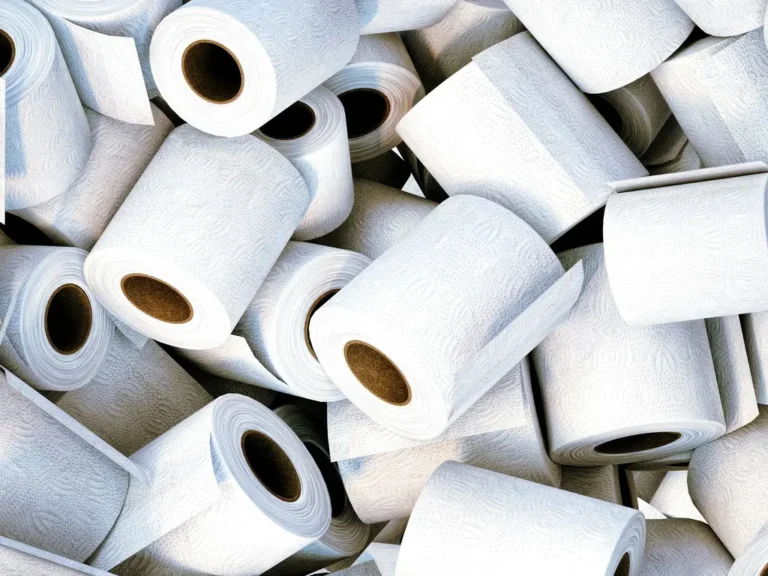The other day, I found myself tossing a used tissue into the recycling bin, feeling pretty good about doing my part for the planet. But then a question popped into my head—is tissue paper recyclable? It’s not something we think about much, right? I mean, we use tissues for everything but we don’t know how it can impact the planet.
Here’s the short answer: most tissue paper isn’t recyclable. I know, it sounds surprising. It should go in the recycling bin with all the other paper. But tissues are different. The way they’re made, and the way we use them, makes recycling nearly impossible. Whether contaminated by food, grease, or too thin to repurpose, most tissues end up in the trash. But don’t worry, there’s more to this story—and it’s not all bad news.
So, let’s explore the full picture. What is tissue paper made of? Why can’t it be recycled? And what can you do instead? Stick with me—this is about making small, easy changes that make a difference.
Understanding Tissue Paper
Tissue paper is a thin, soft paper designed for single use. It’s a lightweight, easy-to-tear, and highly absorbent product. We use tissue paper daily for personal hygiene, in the form of toilet paper, facial tissues and paper towels. But have you ever wondered why it’s so common and what makes it a go-to product? Let’s understand.
What Exactly is Tissue Paper?
At its core, tissue paper is made with wood pulp, which comes from virgin wood fibers, recycled materials, or bamboo. It is designed to be soft and gentle on the skin, specifically for hygiene and cleaning purposes. As a result, it is thinner and more delicate than other paper products we use.
Why Do We Use It So Much?
We mostly use tissue paper for our convenience. Here are some of its most common uses:
- Toilet Paper: For personal hygiene.
- Facial Tissues: Ideal for blowing your nose, wiping tears and dabbing away sweat.
- Paper Towels: Used to clean up spills in the kitchen or around the house.
- Napkins: A must-have at the dinner table for wiping hands and mouths.
- Gift Wrapping Tissue: Adds a decorative touch to presents and protects fragile items.
Why It’s So Popular
- Single-Use Convenience: You use it once and throw it away—no washing, drying, or reusing required.
- Hygienic: Tissue paper is disposable and reduces the risk of spreading germs, which is especially important for personal hygiene and food handling.
- Affordable: It is affordable and accessible for everyone.
- Versatile: From cleaning spills to wrapping gifts, tissue paper has a role in almost every aspect of daily life.
- Portable: Small packs of tissues are easy to carry, so you’re always prepared.
Is Tissue Paper Recyclable?
Recycling tissue paper largely depends on two factors: cleanliness and the length of fiber used in its production. After use, it often gets contaminated with food, grease, or bodily fluids, as we mainly use it for cleaning purposes. Additionally, tissue paper is made from short fibers that are too weak to be processed again in paper mills.
Most recycling programs exclude tissue paper because of these challenges. Contamination from use and the inherent weakness of the fibers makes it difficult to process again. Even unused tissue paper is rejected due to its low-grade fibers because it does not meet the quality standards required for recycling.
Types of Tissue Paper and Their Recyclability
1. Hygienic Tissue Paper
Includes the tissue paper we use every day for personal hygiene and cleaning, such as:
- Toilet Paper
- Facial Tissues (Kleenex, etc.)
- Napkins
Once they’ve been used, they can’t be recycled. It gets contaminated with things like oil, food, etc. The best way to dispose of it:
- Compost: Composting tissue paper is an environment friendly approach to dispose of it. Plain, non-dyed, and unbleached tissue paper, breaks down and transforms into carbon-rich nutrients for the soil.
- Proper Disposal: If you can’t compost, the next best option is to dispose of tissue paper in the regular trash. It’s not ideal, but it’s often the only option for contaminated tissue paper.
2. Gift Wrapping Tissue Paper
Decorative tissue paper is mostly used to wrap gifts, while plain tissue paper can be used as well. The discussion starts when decorated tissue paper is used. These tissues contain chemicals and shiny coatings and complicate the recycling efforts.
You can easily send plain tissue in the compost bin. But if it is glittery or foiled, sending it to the trash is the only option.
3. Industrial Tissue Paper
Think about the big rolls of paper towels, wipes, and tissues you see in commercial settings like restaurants, hospitals, or office buildings. These often fall into the “industrial tissue paper” category.
Most of the time these tissues are treated with harsh chemicals to increase absorbency and strength. Such treatments (like fragrances, bleach, or other chemicals) make them non-recyclable, even if they are unused.
What you can do:
- Trash: These should generally go to the trash because of the chemical treatment they go through.
- Waste-to-Energy: The waste-to-energy process is another alternative practice. In this process, the tissue paper is burnt to generate energy. This method helps reduce landfill waste and recover some energy from the waste material.
Sustainable Alternatives to Tissue Paper
1. Reusable Cloth Napkins
Cloth napkins are the perfect replacement for disposable ones. They are durable, washable, and highly versatile. Instead of throwing a napkin after use, you can wash and reuse it hundreds of times. Not only will you save money in the long run, but you’ll also cut down on paper waste.
So, next time you’re sitting down for a meal, reach for a cloth napkin and skip the tissue paper.
2. Handkerchiefs
Think about how frequently you reach for a tissue when you have a cold, allergies, or just to wipe your face. Instead of grabbing a tissue every time, why not switch to a handkerchief? Handkerchiefs are reusable and washable, and they can replace multiple disposable tissues, which pile up fast.
Benefits:
- Long-lasting: A handkerchief can last years, unlike tissues that you toss after one use.
- Eco-friendly: By using fewer tissues, you’re helping reduce paper waste.
- Convenient: They’re small and easy to carry in your pocket or bag.
3. Bamboo Tissues
One of the most sustainable options out there. Bamboo tissues are biodegradable, they’ll break down naturally and won’t sit in a landfill forever like traditional tissue paper.
Benefits:
- Biodegradable: Bamboo tissues break down naturally in the environment.
- Sustainable: Bamboo grows rapidly, making it a great renewable resource.
- Soft yet Strong: Bamboo tissue is just as soft as regular tissue but much more eco-friendly.
4. Compostable Paper Towels
If you prefer the convenience of disposable paper towels, compostable ones are a great option. Unlike regular paper towels, which don’t break down easily in landfills, compostable paper towels are designed to break down naturally. They’re typically made from unbleached, recycled materials, which reduces their environmental impact.
Benefits:
- Compostable: These towels break down naturally and return to the Earth without leaving harmful waste behind.
- Sustainable: They’re made from recycled or renewable resources.
- Convenient: Still an option for when you need paper towels but don’t want the environmental guilt.
Conclusion: Is Tissue Paper Recyclable?
So, next time you reach for a tissue, remember that the answer to “Is tissue paper recyclable” is usually no. But don’t worry—you’ve got options! You can compost it, use waste-to-energy methods, or choose eco-friendly alternatives. Every small change helps protect our planet. Understanding what can and can’t be recycled, you’re already making a positive impact. Keep making those green choices, together, we can create a cleaner, greener world!




